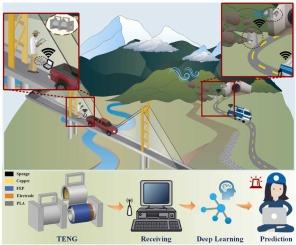当前位置:
X-MOL 学术
›
Nano Energy
›
论文详情
Our official English website, www.x-mol.net, welcomes your
feedback! (Note: you will need to create a separate account there.)
Deep-learning-assisted self-powered wireless environmental monitoring system based on triboelectric nanogenerators with multiple sensing capabilities
Nano Energy ( IF 16.8 ) Pub Date : 2024-10-30 , DOI: 10.1016/j.nanoen.2024.110301 Long Liu, Xinmao Zhao, Tong Hu, Fei Liang, Binyong Guo, Kai Tao
Nano Energy ( IF 16.8 ) Pub Date : 2024-10-30 , DOI: 10.1016/j.nanoen.2024.110301 Long Liu, Xinmao Zhao, Tong Hu, Fei Liang, Binyong Guo, Kai Tao

|
Since the invention of the Triboelectric Nanogenerator (TENG), researchers have used this technology to facilitate the harvesting of environmental energy, such as wind and vibration, as well as the sensing of environmental parameters, such as wind speed and geological changes, resulting in the development of self-powered environmental monitoring systems. Nonetheless, the complex and ever-changing natural environment requires that the system not only complete a wide range of monitoring tasks but also provide remote and instantaneous wireless sensing capabilities. This work proposes a self-powered wireless environmental monitoring system based on a configurable Rotary Switch TENG (RS-TENG), which integrates deep learning algorithms and is capable of multi-parameter environmental monitoring. The RS-TENG can work with wind and record speed information; a capacitive strain sensor equipped on bridges and an inductive weight sensor plated around mountains are also considered monitoring nodes for multi-parameter monitoring in the natural environment. A resonant circuit and a tip-discharge structure allow the steady transmission of wireless signals that carry significant bridge component deformation and rockfall information to the user interface for decision-making. With deep learning algorithms, the system detects the deformation states of bridge components and rockfall warning signals and identifies defined levels. By adopting a shared wind cup, the RS-TENG allows the node to power electronic devices while enabling entirely automatic wireless wind monitoring. Furthermore, a user-friendly visualization interface is built for this environmental monitoring system, which allows users to assign monitoring tasks and get reasonable results. This work provides a paradigm for TENG technology applied in self-powered wireless environmental monitoring in complicated and particular natural environments.
中文翻译:

基于具有多种传感能力的摩擦纳米发电机的深度学习辅助自供电无线环境监测系统
自摩擦纳米发电机 (TENG) 发明以来,研究人员一直使用这项技术来促进环境能量(如风和振动)的收集,以及环境参数(如风速和地质变化)的传感,从而开发出自供电环境监测系统。尽管如此,复杂多变的自然环境要求系统不仅要完成广泛的监控任务,还要提供远程和即时的无线传感功能。本工作提出了一种基于可配置旋转开关 TENG (RS-TENG) 的自供电无线环境监测系统,该系统集成了深度学习算法,能够进行多参数环境监测。RS-TENG 可以处理风并记录速度信息;安装在桥梁上的电容式应变传感器和在山上镀层的电感式重量传感器也被认为是自然环境中多参数监测的监测节点。谐振电路和尖端放电结构允许无线信号稳定传输,这些信号将重要的桥梁构件变形和落石信息传输到用户界面以供决策。借助深度学习算法,该系统可以检测桥梁组件的变形状态和落石警告信号,并确定定义的水平。通过采用共享风杯,RS-TENG 允许节点为电子设备供电,同时实现全自动无线风监测。此外,该环境监测系统构建了一个用户友好的可视化界面,允许用户分配监测任务并获得合理的结果。 这项工作为TENG技术在复杂和特定自然环境中的自供电无线环境监测中的应用提供了一个范例。
更新日期:2024-10-31
中文翻译:

基于具有多种传感能力的摩擦纳米发电机的深度学习辅助自供电无线环境监测系统
自摩擦纳米发电机 (TENG) 发明以来,研究人员一直使用这项技术来促进环境能量(如风和振动)的收集,以及环境参数(如风速和地质变化)的传感,从而开发出自供电环境监测系统。尽管如此,复杂多变的自然环境要求系统不仅要完成广泛的监控任务,还要提供远程和即时的无线传感功能。本工作提出了一种基于可配置旋转开关 TENG (RS-TENG) 的自供电无线环境监测系统,该系统集成了深度学习算法,能够进行多参数环境监测。RS-TENG 可以处理风并记录速度信息;安装在桥梁上的电容式应变传感器和在山上镀层的电感式重量传感器也被认为是自然环境中多参数监测的监测节点。谐振电路和尖端放电结构允许无线信号稳定传输,这些信号将重要的桥梁构件变形和落石信息传输到用户界面以供决策。借助深度学习算法,该系统可以检测桥梁组件的变形状态和落石警告信号,并确定定义的水平。通过采用共享风杯,RS-TENG 允许节点为电子设备供电,同时实现全自动无线风监测。此外,该环境监测系统构建了一个用户友好的可视化界面,允许用户分配监测任务并获得合理的结果。 这项工作为TENG技术在复杂和特定自然环境中的自供电无线环境监测中的应用提供了一个范例。


















































 京公网安备 11010802027423号
京公网安备 11010802027423号